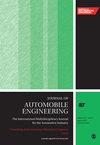Synergistic thermal management of lithium-ion batteries in electric two-wheelers: Critical analysis and ranking of multifaceted strategies and numerical validation
IF 1.5
4区 工程技术
Q3 ENGINEERING, MECHANICAL
Proceedings of the Institution of Mechanical Engineers Part D-Journal of Automobile Engineering
Pub Date : 2024-08-23
DOI:10.1177/09544070241272767
引用次数: 0
Abstract
The paradigm shift from conventional to electric propulsion has become one of the pivotal foci of research areas. In the electric vehicle domain which encompasses a range of vehicles from two-wheelers to multi-wheelers, the battery thermal management system and its design variations are receiving the utmost attention. This article explores an array of distinct cooling strategies viz. evaporative, refrigeration assisted, mist, vapour chamber, thermoelectric and MEMS membrane cooling for lithium-ion batteries with their specifications, prominent attributes, advantages, limitations and thermal mitigating measures with potential future possibilities for electric two-wheelers. Grey relational analysis (GRA) is adopted to rank the cooling schemes disclosed that mist cooling is the most optimal for electric two-wheelers and this recommendation is substantiated with a numerical approach. The numerical results unveiled that the multi-strategical approach of mist cooling and forced convection attenuated the peak cell temperature by 13% and 24% when compared to stand-alone mist cooling and the system without external cooling assistance. This stands as evidence for the increased effectiveness of multi-strategical approaches. The article would help in creating the most practical combinational cooling solutions to lessen the danger of a thermal runaway with lithium-ion batteries, in particular, implemented in electric two-wheelers.电动两轮车中锂离子电池的协同热管理:多方面策略的批判性分析和排序以及数值验证
从传统推进模式到电力推进模式的转变已成为研究领域的关键焦点之一。在电动汽车领域,包括从两轮车到多轮车的一系列车辆,电池热管理系统及其设计变化受到极大关注。本文探讨了一系列不同的冷却策略,即锂离子电池的蒸发、制冷辅助、雾化、蒸气室、热电和 MEMS 薄膜冷却,以及它们的规格、突出属性、优势、局限性和热缓解措施,以及未来电动两轮车的潜在可能性。采用灰色关系分析法(GRA)对冷却方案进行排序,结果表明,对于电动两轮车而言,雾状冷却是最理想的,并通过数值方法证实了这一建议。数值结果表明,与单独的喷雾冷却和无外部冷却辅助的系统相比,喷雾冷却和强制对流的多策略方法分别将电池的峰值温度降低了 13% 和 24%。这证明了多策略方法的有效性。这篇文章将有助于创建最实用的组合冷却解决方案,以降低锂离子电池热失控的危险,特别是在电动两轮车中的应用。
本文章由计算机程序翻译,如有差异,请以英文原文为准。
求助全文
约1分钟内获得全文
求助全文
来源期刊

CiteScore
4.40
自引率
17.60%
发文量
263
审稿时长
3.5 months
期刊介绍:
The Journal of Automobile Engineering is an established, high quality multi-disciplinary journal which publishes the very best peer-reviewed science and engineering in the field.
 求助内容:
求助内容: 应助结果提醒方式:
应助结果提醒方式:


